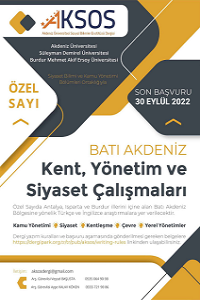Tarihi ve Yeni Gelişme Alanlarında Camilerin Kullanım Yoğunlukları ve Fiziksel Çevre Özellikleri, İzmir-Türkiye
Bu çalışma tarihi
kent merkezindeki ve yeni gelişme alanındaki camilerin kullanım yoğunlukları
ile yakın çevrelerindeki fiziksel çevre karakteristikleri arasındaki ilişkiyi
tartışmaktadır. Tarihi kent merkezindeki camileri temsil etmek üzere İzmir
kenti Kemeraltı Bölgesinde konumlanan yedi adet cami ve yeni gelişme
alanlarındaki camileri temsil etmek üzere İzmir kenti Mavişehir-Şemikler
Bölgesinde yer alan üç adet cami seçilmiştir. Seçilen on adet cami için kullanım
yoğunluğu ve anılan camilerin yakın çevresindeki mekânların morfolojik
özellikleri analiz edilmiştir. Sonuçlar tarihi kent merkezinde ve yeni gelişme
alanlarında konumlanan camilerin yakın çevrelerinde fiziksel çevre özelliklerinin
(arazi kullanımı ve sokak dokusu ve erişilebilirliği) farklılaştığını göstermiştir.
Bu sonuçlara paralel olarak, kullanım yoğunluğu da tarihi alanlarda yeni
gelişme alanlarına göre daha yüksektir. Metodolojik eksikliklerine (rağmen küçük
örneklem büyüklüğü vb.) bu çalışma, camilerin kullanım yoğunluğu ve mekânsal
özellikler arasındaki ilişkiyi analiz ederek, mekân ve insan davranışları
arasındaki ilişkiyi irdeleyen çevre psikolojisi disiplinindeki araştırmalara
örnek teşkil etmektedir.
Anahtar Kelimeler:
Erişilebilirlik, Çevre Psikolojisi, Camiler, Mekân Dizimi, İzmir
Mosque Use Density and Physical Environmental Characteristics around the Mosques in Historical and New Development Areas of İzmir, Turkey
This paper aims to compare the mosque use density and
physical environmental characteristics around mosques in two types of areas: in
historical city centres and in contemporary areas in the periphery are
compared. A total of ten mosques were analyzed; seven were located in the city
centre (Kemeraltı district), three were located in new development areas
(Mavişehir-Şemikler district). Results showed differences in street network
pattern and physical environmental characteristics in two areas. In parallel, use
density was higher in historical city centres than that in contemporary areas.
Despite the methodological limitations (small sample size etc.), this study is
important in highlighting the relation between physical environment and
people’s behaviour in the case of mosque use.
Keywords:
Accessibility, Environmental Psychology, Mosques, Space Syntax, İzmir,
___
- Ayhan, I., & Cubukcu, K. M. (2010). Explaining historical urban development using the locations of mosques: A GIS/spatial statistics-based approach. Applied Geography, 30(2), 229-238.
- Ahmad Basri, S., & Suhanna, S. (2008). Lessons from Traditional Towns and Cities in Malaysia for Sustainable Future Places. Ahmad Basri, S. and Mouktar, MM Urban Design Issues in the Developing World: The Case of Malaysia and Nigeria, 1-21.
- Chiodelli, F. (2015). Religion and the city: A review on Muslim spatiality in Italian cities. Cities, 44, 19-28.
- Dhingra, M., & Chattopadhyay, S. (2016). Advancing smartness of traditional settlements-case analysis of Indian and Arab old cities. International Journal of Sustainable Built Environment, 5(2), 549-563.
- Farhat Harb, D. (2015). Walkability Potential in the built environment of Doha City. In 12th International Post-Graduate Research Conference, 2015 proceedings (pp. 94-108).
- Hamid, G. G., Mikhail, S., & Estamboli, M. J. (2012). The position of mosque in Islamic cities and its location design in new cities. Damascus University, 28(1).
- Hillier, B., Penn, A., Hanson, J., Grajewski, T., & Xu, J. (1993). Natural movement: or, configuration and attraction in urban pedestrian movement. Environment and Planning B: planning and design, 20(1), 29-66.
- Kershen, A., & Vaughan, L. (2013). “There was a priest, a rabbi and an imam…”: an analysis of urban space and religious practice in london's east end, 1685–2010. Material Religion, 9(1), 10-35.
- Klarqvist, B. (1993). A space syntax glossary. Nordisk Arkitekturforskning, 2(1).
- Mahboubeh, R., Fatemeh, T., & Nasim, T. (2011, April). Criteria of integration of sociability and physical environment in sustainable developments (The case study of Malaysia). In Modeling, Simulation and Applied Optimization (ICMSAO), 2011 4th International Conference on (pp. 1-7). IEEE.
- Mazumdar, S., & Mazumdar, S. (2004). Religion and place attachment: A study of sacred places. Journal of environmental psychology, 24(3), 385-397.
- ÖZGEN, C. (2012). Increasing walkability capacity of historic city centers: The case of Mersin (Doctoral dissertation, MIDDLE EAST TECHNICAL UNIVERSITY).
- Ratti, C. (2004). Space syntax: some inconsistencies. Environment and Planning B: Planning and Design, 31(4), 487-499.
- Saberi, A., Motamedi, S., Shamshirband, S., Kausel, C. L., Petković, D., Endut, E., ... & Roy, C. (2016). Evaluating the legibility of decorative arabic scripts for Sultan Alauddin mosque using an enhanced soft-computing hybrid algorithm. Computers in Human Behavior, 55, 127-144.
- Saoud, R. (2002). Introduction to the Islamic city. FSTC Limited.
- Şahinalp, M. S., & Günal, V. (2012). OSMANLI ŞEHİRCİLİK KÜLTÜRÜNDE ÇARŞI SİSTEMİNİN LOKASYON VE ÇARŞI İÇİ KADEMELENME YÖNÜNDEN MEKÂNSAL ANALİZİ. Milli Folklor, 24(94).
- Sharifi, A., & Murayama, A. (2013). Changes in the traditional urban form and the social sustainability of contemporary cities: A case study of Iranian cities. Habitat International, 38, 126-134.
- ISSN: 2564-7091
- Yayın Aralığı: Yılda 2 Sayı
- Başlangıç: 2017
- Yayıncı: Akdeniz Üniversitesi
Sayıdaki Diğer Makaleler
İttihat ve Terakki Döneminde Milli İktisat Anlayışı (1913-1918)
Türkiye’nin AB Üyeliğine Almanya’daki Siyasi Partilerin Bakışı
İkinci Dünya Savaşı Döneminde Sovyet Ordusuna Çocuk Desteği: Tüm Birlik Pioner Teşkilatı
Afganistanda Bulunan Bir Divan-ı Hikmet Yazması
Okul Öncesi Eğitim Sınıflarındaki Bilim Eğitimi Öğrenme Merkezlerinin İncelenmesi
Berrin AKMAN, Merve GANGAL, Servet KARDEŞ
Coğrafi Ortam ve Yerleşme Adları Arasındaki İlişki Açısından İdil İlçesi (Şırnak) Köy Adları
Abdülkadir GÜZEL, Mehmet ÖZCANLI
